-
Posts
1,287 -
Joined
-
Last visited
-
Days Won
32
Content Type
Profiles
Forums
Blogs
Gallery
Events
Store
Posts posted by oamotme
-
-
-
Dear Brian,
For many years I only had the miniature of this obscure / scarce award and never expected to see let alone acquire a full size one - however I was fortunate and now have one. To my mind this award dates from the commencement of the second series of the Khedive's Sudan Medal (1910?) and only appears to have the Abbas Hilmi obverse. The scroll suspension would echo the British DCM medal. I attach images of the one in my collection - no naming though and the ribbon is modern. Sultan Hussain Kamel instituted the Orders of Mohammed Ali, Ismail and Nile in 1915 and the Order of Mohammed Ali also included two bravery medals in gold and silver which I would suggest replaced the Abbas Hilmi bravery medal - Khedive Abbas Hilmi being ousted by the British in December 1914 and replaced by Hussain Kamel who was given/took the title Sultan. On this basis the award was very short lived (1910-14 or 15?) and to date I have found no evidence of its award to British personnel. The Mohammed Ali Bravery Medals in turn became obsolete (possibly?) with the institution of Military Star of King Fuad. Fuad became Sultan in 1917 and his monogram replaced that of Abbas Hilmi on the 2nd Series Khedive's Sudan Medal. Fuad became King in 1922.
Effectively next to no documentary history for this award - unless of course someone knows otherwise........
KInd regards from Riyadh,
Owain.
P.S. From comparing the images yours are of the medal I have - small world!
1 -
Wil / Paul,
There are four awards in this series, all instituted and noted in the Sudan Defence Force Gazette of 4 November, 1933:
Distinguished Service Decoration (Silver)
Native Officer's Decoration (Silver)
Long Service & Good Conduct Medal (Bronze)
General Service Medal (Silver)
Wil - the one with the camel is the Distinguished Service Decoration - the scarcest of the series - is yours named?
The recent DNW auction had all four for sale as singles - I am missing the Native Officers Decoration from my collection and was outbid at the auction!
Regards,
Owain.
0 -
Linas, Again a fairly common and cheap piece - seemy notes below, Regards, Owain.
Obverse A circular medal edged with a green enamel laurel wreath. In the centre a map of Palestine and the Jordan Valley with the inscription to the left and right, “Palestine 1948” At the top of the medal are two crossed scimitars between the blades of which is the dome of a mosque which is surmounted by a crescent. A church is superimposed upon the dome.
Reverse Blank.
Classes One.
Size 36mm diameter.
Metal Bronze.
Ribbon 37mm red with a 6mm white stripe inset 6mm from each edge.
Suspension By a loop soldered to the rear of the medal.
Instituted Legislative Decree No. 13 of the 18th of December, 1951.
This Order is awarded in commemoration of the various battles fought by the Syrian Army since 1948. It is awarded to soldiers and to civilians and also to foreigners who distinguish themselves during these conflicts. It may be awarded posthumously.
0 -
Linas, These are very common pieces - see my notes below, egards, Owain.
Obverse An eight pointed multi rayed star with a central circular medallion. The upper half is an inverted crescent whilst the bottom half has a green enamel wreath of laurels tied at the base. In the centre an armed cavalry man astride a galloping horse, below which is the inscription in black, “Order of Bravery”
Reverse Blank.
Classes Three.
Size 1st Class 60 mm diameter.
2nd Class 50 mm diameter
3rd Class 40 mm diameter
Metal Bronze.
Ribbon 36 mm blue ribbon with three 4 mm white stripes, each of which have a central 1 mm red stripe. A bronze oak leaf is worn on the ribbon to indicate further awards.
Suspension By a small wreath affixed to the uppermost point of the star.
Instituted Legislative Decree # 15, 20th July 1964.
This medal is awarded to members of the Syrian Armed Forces who display courage and valour during military operations. Award of the medal was to be extended in 1976 to also include civilians and foreigners. The three classes are awarded as follows:
First Usually officers.
Second Usually Non Commissioned Officers.
Third For soldiers and others
The Order of Bravery may also be awarded for displaying courage in the public interest and for carrying out exceptional activities and public services in favour of the State or the display of self sacrifice in saving life, property or national wealth.
0 -
Lorenzo ,
Although the orders were sometimes of British manufacture they were also made in France and most of the medals were of Swiss manufacture so it is more than likely that the brooch bars are of European manufacture.
Regards, Owain
0 -
Lorenzo,
You describe the bars as British style - as a former British army officer I do not recognise this format - British ribbons are invariably mouted in a row and then sewn directly onto the tunic jacket and are not pinned on by brooch clips.
Regards,
Owain
0 -
Scott,
The writing on the reverse of your ribbon bar reads "Khiatah Bilqis" or Bilqis Tailors - if I remember my history correctly Builqis is the Arabic name of the Queen of Sheba!
Regards,
Owain
0 -
And the second:
 0
0 -
Images of the reverse:
 0
0 -
And another:
Order of Rafidain
Bravery Medal
Active Service Medal
1938-1945 War Medal
Both are in mint condition and have snap buttons on the reverse - probably never been used.
Regards,
Owain
 0
0 -
Gentlemen,
I attach images of two nice pre-revolution ribbon bars. The first:
Order of Rafidain
Bravery Medal
Active Service Medal
1939-45 War Medal
1945 Victory Medal
Regards,
Owain
 0
0 -
Ribbon Colors:
-Red White Red, Medal for Valour
-Green White Green, Medal for Achievement
-Red White Red White Black 3 green Stars, Medal for Wounded ("This is the medal you have displayed")
-Red White Black White Black 3 green Stars, Medal for Killed in Action
I hope you understand this, in order of color of the mounting system/ribbon
Sad to see you only post to sale an item and not for the research;)
Lorenzo
Lorenzo may well be correct - the identification I have given was that supplied to me by a fellow collector in Germany whose brother had some how been involved with the purchase or manufacture of the awards. However in submitting my draft to JOMSA the Editor advised that a similar draft had been submitted by Ed Emering and the two were combined and published in the November-December 2007 issue of JOMSA and the identification therein follows that given by Lorenzo.
Owain
0 -
Gentlemen,
From my notes in 2004 for an article later published by JOMSA:
"It would appear than, despite continuing military action that new medals have been, in 2004, produced for Iraqi personnel who are part of the new Iraqi Army, which is in the process of being currently established. This series of four awards are illustrated above and are, from left to right, as follows:
- Wounded in Action Medal, (35mm diameter).
- Killed in Action Medal (35mm diameter).
- Medal of Achievement (42mm diameter).
- Medal for Valour (42 mm diameter).
Whilst some 2000 Medals for Achievement have been manufactured the other three medals have been limited to production runs of 1,000 each. The reverses of all four medals are blank. The ribbons are all 26mm in width and 34mm in length. The medals, of gilded and enamelled base metal are of high quality and each comes in a plain blue velvet-like case, 106 mm x 76 mm. These medals, or so it appears, are to be awarded to the new Iraqi security forces – army and police by the U.S. Military, accordingly their status can be inferred as quasi-official.
I have been advised that the procurement order emanated from the U.S. 101. Infantry Division and thus are not official government awards. A German company was contracted to manufacture these medals. In turn it appears that the German company sub-contracted the order out to a company in mainland China.
With regard to the design the Arabic inscription for Republic of Iraq on all four reads “Al Jumhoriya Al Iraqiya” which was last used on Saddam era awards prior to 1990, thereafter the inscriptions read “Jumhoriyat Al Iraq” - the difference in Arabic being that the former is the feminine and the latter masculine. Also at this time the Iraqi flag upon the eagle changed from horizontal to vertical and the Arabic inscription “Allahu Akbar” (God is Great) was added to the flag. Thus the medals are a mix of old and new Saddam styles. Finally the eight-pointed star format of the Achievement and Valour Medals is a style adopted by the Saddam regime and occurs in a series of badges and architectural designs."
Regards,
Owain
0 -
Wil,
Great piece of history - congratulations!
Owain
0 -
Hi,
The first one is Arabian - known as a "dharia" probably from the south west of what is now Saudi Arabia. The second dagger is Morrocan.
With regard to value not I suspect a vast amount as both are relatively common place.
Regards, Owain.
0 -
Christer,
This is the Second Class Medal of the Order of the Homayoun of the Pahlavi period. The date period you suggest may well be correct and it is probably manufactured by Bertrand of Paris. You note a bestowal certificate accompanies this cased piece. I would suggest the price is fair to good.
Regards,
Owain.
0 -
Rihab,
Well done on getting a named Levy pair /group. There cannot be to many Levies who served long enough to get a GSM and LSGC although there must be others out there!
The Assyrian Levies were raised in 1919 for local defence but did see offensive action. In October 1922 they were transferred from British Army to RAF control.
Owain.
0 -
Nice one Will - you score again!
Owain
0 -
Tony,
I thought it was the 1961-71 issue and I attach images of the Siaka Stevens LSGC which I think is the 1971-85 issue. Anway I may well be wrong - a picture of a QEII obverse/reverse would resolve this.
Kind regards,
Owain.
P.S. Is this post drifting towards the Africa part of GMIC?
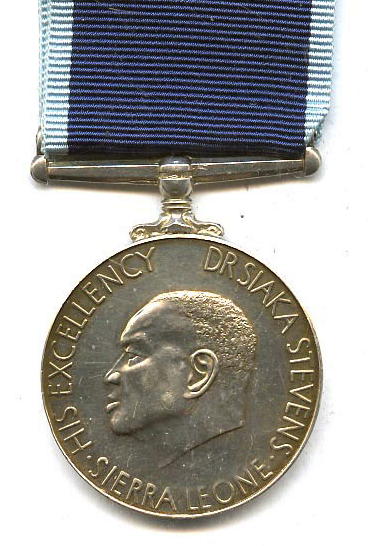
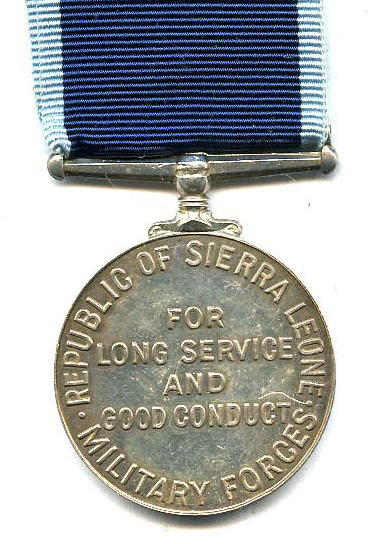 0
0 -
Tony,
I add some images of the 1961-71 issue LSGC medal.
Owain
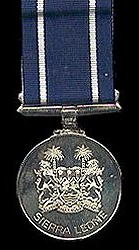
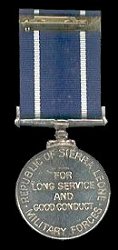 0
0 -
Dear Tony,
With regard to Sierra Leone's Long Service and Good Conduct Medal this is a circular silvered medal, with a fixed straight bar suspension bearing the arms of the nation above the inscription, "SIERRA LEONE". The reverse bears the inscription "FOR LONG SERVICE AND GOOD CONDUCT" surrounded by "REPUBLIC OF SIERRA LEONE MILITARY FORCES". The ribbon is of blue with narrow inset white stripes. The qualifying period for this award is, I believe, 15 years service. Subsequent to the proclamation of the Republic in 1971 a second type was instituted bearing on the obverse the head of President Stevens and the inscription "HIS EXCELLENCY DR. SIAKA STEVENS SIERRA LEONE". The reverse is the same as Type 1. The ribbon in this instance is dark blue with narrow light blue edge stripes. Dr. Stevens was President from 1971 to 1985.
Before and after independence in 1961 the Sierra Leone Military was known as the Royal Sierra Leone Military Forces (RSLMF). On 19 April 1971 when the country became a republic, the name was changed to Republic of Sierra Leone Military Forces (RSLMF). When the National provincial Ruling Council (NARC) took over the reigns of government on 29 April 1992 the military was renamed the Armed Forces of the Republic of Sierra Leone (AFRSL). In 2000, after the interregnum, it was again changed to Republic of Sierra Leone Armed Forces (RSLAF).
Kind regards,
Owain
0 -
On comparing your piece with those in my collection I am fairly certain yours is the Mohammed Al Naceur issue of 1906-1922 - 4th Class or Officer issue.
Regards,
Owain
0 -
Hi,
The central disc is upside down and the focus is unclear but the first part is Mohammed. A clearer image would help.
Owain
P.S. It is the Order of Glory (Nishan Al Iftikhar)
0



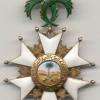




Syria medal ?
in Middle East & Arab States
Posted · Edited by oamotme
Ilja,
I think the reverse notes "The 33rd Anniversary (1970-2003) of the xxxxxxx Movement of 16 of Tishreen" - one of a series of semi-official medalions issued each year as momentos or souvenirs. As Chris notes the desgin is painful - good Syrian Baathist / socialist bling
Regards,
Owain.